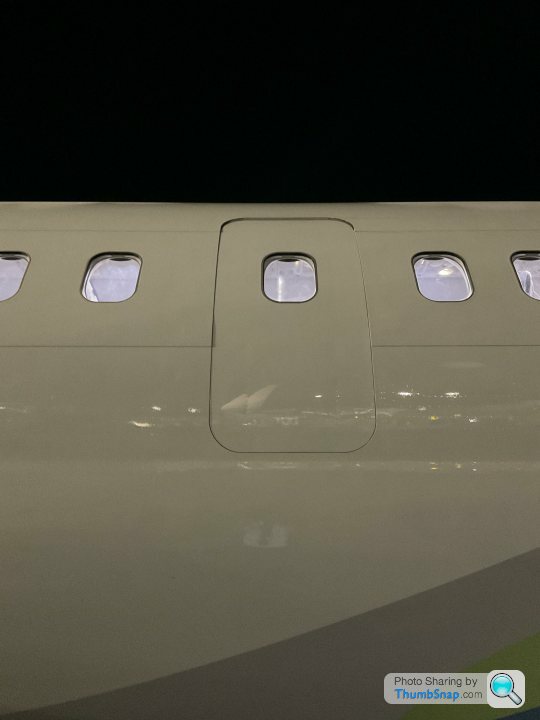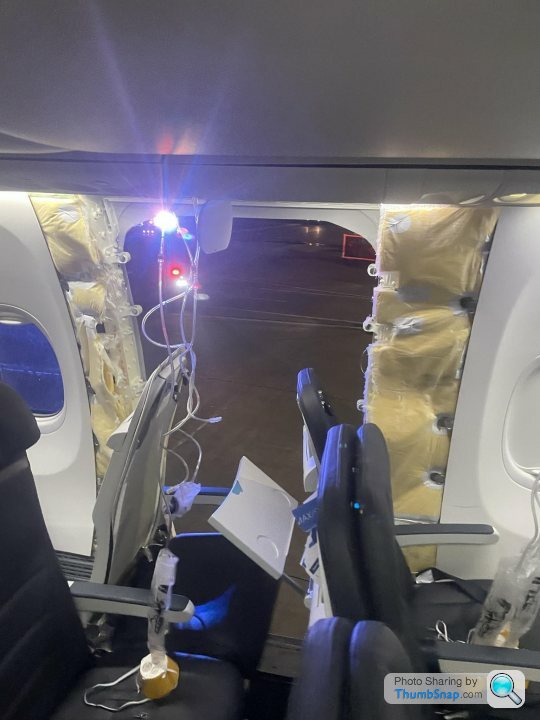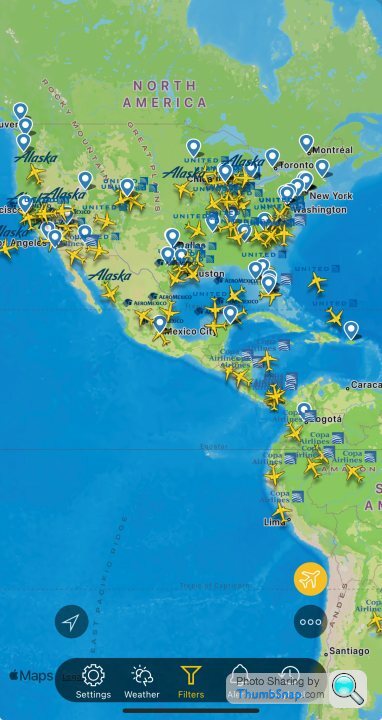737 max loses window
Discussion
Teddy Lop said:
Don't see why you can't pressure test an aircraft by pressurising it on the ground to an equivalent differential it will use in flight.
Wouldn't that risk a massive explosion if/when the test failed? I accept you could perhaps raise the pressure a bit and then wander about a nice, quiet aircraft looking for a suspicious hissing sound. There's some interesting footage of how they found out why Comets were falling out of the sky. They put a Comet in a huge water tank and simulated flights until it blew.
https://www.youtube.com/watch?v=Lq1jZC9FUTw
Panamax said:
Wouldn't that risk a massive explosion if/when the test failed? I accept you could perhaps raise the pressure a bit and then wander about a nice, quiet aircraft looking for a suspicious hissing sound.
There's some interesting footage of how they found out why Comets were falling out of the sky. They put a Comet in a huge water tank and simulated flights until it blew.
https://www.youtube.com/watch?v=Lq1jZC9FUTw
Indeed - here at Farnborough.There's some interesting footage of how they found out why Comets were falling out of the sky. They put a Comet in a huge water tank and simulated flights until it blew.
https://www.youtube.com/watch?v=Lq1jZC9FUTw
One of the fuselages they used was lying under the trees (in a type of cocoon) as late as 1978. I remember seeing it when I went to the airshow that year. I think it might be this fuselage which is now at the de Havilland Museum.

Panamax said:
Teddy Lop said:
Don't see why you can't pressure test an aircraft by pressurising it on the ground to an equivalent differential it will use in flight.
Wouldn't that risk a massive explosion if/when the test failed? I accept you could perhaps raise the pressure a bit and then wander about a nice, quiet aircraft looking for a suspicious hissing sound. There's some interesting footage of how they found out why Comets were falling out of the sky. They put a Comet in a huge water tank and simulated flights until it blew.
https://www.youtube.com/watch?v=Lq1jZC9FUTw
CanAm said:
Jasey_ said:
Luckily the seat immediately next to the broken fuselage was said by passengers to be unoccupied. It's aisle seats for me from now on!.
PS "loses window" is a bit of an understatement !!
Did they leave that seat unoccupied because of the previous warning(s) !!!!
Panamax said:
That's interesting, thanks.
But why would you ever deactivate one possible means of escape? You won't know it's needed unless and until the excrement meets the extractor. For instance, all those JAL passengers evacuated through one side of the aircraft.
And how would deactivation (how exactly is that done? Electrical switch? Clamp the handle?) of the opening panel of the door affect the whole frame blowing out of the aircraft?
I'm trying to imagine a sequence of events,
It's deactivated because it isn't required by regulations. By regulation the seating capacity used by Alaska Airlines (178 seats) only requires the 4 normal doors (2 forward, 2 rear) and the 4 over wing exits. If they used a higher capacity layout (220 is the maximum allowed), they would need the two extra exits behind the wings.But why would you ever deactivate one possible means of escape? You won't know it's needed unless and until the excrement meets the extractor. For instance, all those JAL passengers evacuated through one side of the aircraft.
And how would deactivation (how exactly is that done? Electrical switch? Clamp the handle?) of the opening panel of the door affect the whole frame blowing out of the aircraft?
I'm trying to imagine a sequence of events,
- Someone tests the door and finds it won't open and close properly.
- This is due to distortion of the frame which is tearing away from the fuselage but nobody notices.
- The aircraft continues flying with an appropriate number of passengers and the door deactivated.
- Further pressurisation cycles continue to tear the frame out of the fuselage.
- There's a flight where it's noticed the plane has difficulty staying pressurised, and that's logged.
- Engineers check "the usual suspects" and can't find any fault. And presumably you can't fully pressure test an aircraft that's sitting on the ground at normal atmospheric pressure.
- No fault found - carry on flying. [This seems to me where the question marks really kick in. Lack of full engineering support at whatever airfield had been the destination? It looks OK - we'll get it fully checked out next time, back at our home base.]
- The next pressure cycle is the last. Presumably blew out during ascent so fortunately all passengers still strapped. Lucky!
Southerner said:
So to clarify, is it presumably the case that the ‘door’ is fitted as essentially a fixed panel at the factory, and never would or have actually functioned as an opening door? And presumably the interior has the normal non-door cabin fittings over it, so you’d never know from the inside that it was anything other than a normal bit of aircraft window?
It would be delivered already deactivated. As far as I am aware, if an airline decides they want it as a proper emergency exit all they would need to do is order new doors from Boeing and change the interior panels/emergency lighting/signs and the seat configuration.The interior is normal looking to the majority of people. The spacing between the windows on that row are different though.
Teddy Lop said:
There is no door. It's like the blank panel for the switch for the optional extras your car doesn't have.
Don't see why you can't pressure test an aircraft by pressurising it on the ground to an equivalent differential it will use in flight.
You can pressure test the aircraft on the ground. On the older 737's you turn a knob on the cabin pressurisation panel in the cockpit.Don't see why you can't pressure test an aircraft by pressurising it on the ground to an equivalent differential it will use in flight.
This is what caused Helios Airways Flight 522 to crash in Greece in 2005 after flying around for hours with with 120 of the 121 occupants unconscious/dead. They had pressurisation issues on a previous flight and a pressurisation test was carried out at the airport before Flight 522. The knob wasn't returned to the correct position. This wasn't noticed and the aircraft didn't pressurise automatically.
airbusA346 said:

https://www.reddit.com/r/aviation/comments/18zux81...
As someone put on another forum "what units do they (Boeing) use to measure their tolerances, refrigerators per football field?"
You'd like to think that's a Friday afternoon special but seeing as it's Boeing the QC inspector didn't see an issue.

Trying to throw us off the scent by paying their shareholders in Euros, sneaky.
Panamax said:
Teddy Lop said:
Don't see why you can't pressure test an aircraft by pressurising it on the ground to an equivalent differential it will use in flight.
Wouldn't that risk a massive explosion if/when the test failed? I accept you could perhaps raise the pressure a bit and then wander about a nice, quiet aircraft looking for a suspicious hissing sound. There's some interesting footage of how they found out why Comets were falling out of the sky. They put a Comet in a huge water tank and simulated flights until it blew.
https://www.youtube.com/watch?v=Lq1jZC9FUTw
_Rodders_ said:
Quite.
You'd like to think that's a Friday afternoon special but seeing as it's Boeing the QC inspector didn't see an issue.

Trying to throw us off the scent by paying their shareholders in Euros, sneaky.
That image would work with Boeing and the FAA/Government too. If I'm remembering correctly one of the issues mentioned after the MAX crashes was that Boeing were self certifying their aircraft, not the FAA.You'd like to think that's a Friday afternoon special but seeing as it's Boeing the QC inspector didn't see an issue.

Trying to throw us off the scent by paying their shareholders in Euros, sneaky.
Jasey_ said:
CanAm said:
Jasey_ said:
Luckily the seat immediately next to the broken fuselage was said by passengers to be unoccupied. It's aisle seats for me from now on!.
PS "loses window" is a bit of an understatement !!
Did they leave that seat unoccupied because of the previous warning(s) !!!!
If there had been a dad in Seat A and he had just popped to the loo, he must have a guardian angel!
Panamax said:
Teddy Lop said:
Don't see why you can't pressure test an aircraft by pressurising it on the ground to an equivalent differential it will use in flight.
Wouldn't that risk a massive explosion if/when the test failed? I accept you could perhaps raise the pressure a bit and then wander about a nice, quiet aircraft looking for a suspicious hissing sound. There's some interesting footage of how they found out why Comets were falling out of the sky. They put a Comet in a huge water tank and simulated flights until it blew.
https://www.youtube.com/watch?v=Lq1jZC9FUTw

The full story - https://theaviationgeekclub.com/the-story-of-the-u...
Panamax said:
Teddy Lop said:
Don't see why you can't pressure test an aircraft by pressurising it on the ground to an equivalent differential it will use in flight.
Wouldn't that risk a massive explosion if/when the test failed? I accept you could perhaps raise the pressure a bit and then wander about a nice, quiet aircraft looking for a suspicious hissing sound. There's some interesting footage of how they found out why Comets were falling out of the sky. They put a Comet in a huge water tank and simulated flights until it blew.
https://www.youtube.com/watch?v=Lq1jZC9FUTw
My father was a flight test observer and did a lot of flying in Comets between the time they were withdrawn from airline service and the time they discovered the cause of the explosive decompressions. Fortunately for him (and me!) they were flying unpressurised and wearing oxygen masks at altitude.
David87 said:
There's over 200 in service, so only a certain specification is under scrutiny. Alaska have already checked some of there. According to the below article it takes 4-8 hours to check each aircraft.https://edition.cnn.com/2024/01/06/us/alaska-airli...
The grounding also only concerns aircraft operated by US airlines or in US territory.
[i]“The FAA will order the temporary grounding of certain Boeing 737 MAX 9 aircraft operated by U.S. airlines or in U.S. territory.
“The FAA is requiring immediate inspections of certain Boeing 737 MAX 9 planes before they can return to flight,” FAA Administrator Mike Whitaker said. “Safety will continue to drive our decision-making as we assist the NTSB’s investigation into Alaska Airlines Flight 1282.”
The Emergency Airworthiness Directive (EAD) that will be issued shortly will require operators to inspect aircraft before further flight that do not meet the inspection cycles specified in the EAD. The required inspections will take around four to eight hours per aircraft.
The EAD will affect approximately 171 airplanes worldwide.“[/i]
From what I can find the airlines which run the deactivated plug door are: Aeroméxico, Alaska Airlines, Copa Airlines, Turkish Airlines, United Airlines, 2x BBJ's (Private Jets). Airlines that use it as an emergency exit: Air Tanzania, Corendon Dutch Airlines, flydubai, Icelandair, Lion Air, SCAT Airlines.
[i]“The FAA will order the temporary grounding of certain Boeing 737 MAX 9 aircraft operated by U.S. airlines or in U.S. territory.
“The FAA is requiring immediate inspections of certain Boeing 737 MAX 9 planes before they can return to flight,” FAA Administrator Mike Whitaker said. “Safety will continue to drive our decision-making as we assist the NTSB’s investigation into Alaska Airlines Flight 1282.”
The Emergency Airworthiness Directive (EAD) that will be issued shortly will require operators to inspect aircraft before further flight that do not meet the inspection cycles specified in the EAD. The required inspections will take around four to eight hours per aircraft.
The EAD will affect approximately 171 airplanes worldwide.“[/i]
From what I can find the airlines which run the deactivated plug door are: Aeroméxico, Alaska Airlines, Copa Airlines, Turkish Airlines, United Airlines, 2x BBJ's (Private Jets). Airlines that use it as an emergency exit: Air Tanzania, Corendon Dutch Airlines, flydubai, Icelandair, Lion Air, SCAT Airlines.
CanAm said:
From the limited information it seems that there was a youngster in Seat B, with his mum in Seat C.
If there had been a dad in Seat A and he had just popped to the loo, he must have a guardian angel!
It's been reported the person who should have been in seat A missed their flight.If there had been a dad in Seat A and he had just popped to the loo, he must have a guardian angel!
If true, a very final destination moment.
Gassing Station | Boats, Planes & Trains | Top of Page | What's New | My Stuff






